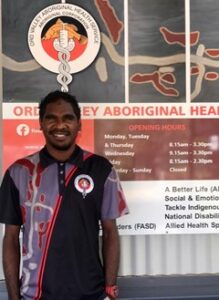OVAHS Tackling Indigenous Smoking (TIS) educators promote the smoke-free & vape-free message through group education and community events.
The TIS program provides:
- Community education programs on smoking and its harmful effects.
- Training and support for workplaces and community spaces to become smoke free.
- Local smoke free campaigns that are meaningful to Aboriginal people.
OVAHS is a non-smoking service promoting a smoke free workplace.

This our TIS educator Raphael Sampi.


Key Facts About the Harmful Effects of Smoking
What makes smoking harmful?
Cigarettes are addictive because of the nicotine they contain. When cigarettes burn, they create more than 4,000 harmful chemicals. Many of these chemicals are used in every day products, for example:
• Acetone – found in nail polish remover
• Arsenic – used in rat poison
• Benzene – found in rubber cement
• Butane – used in lighter fluid
• Carbon Monoxide – released in car exhaust fumes
• Formaldehyde – embalming fluid
What are the harmful effects for smokers?
Lung cancer is the most well-known disease caused by smoking. Smoking also increases the risk of getting other diseases including:
• Other cancers – especially mouth, nose and throat
• Heart disease
• Stroke
• Lung disease – emphysema is commonly caused by smoking
Smoking also makes the symptoms of chronic diseases such as diabetes, asthma and heart disease worse. This is because smoking cigarettes harms nearly every organ in the body, reducing general health and wellbeing. Quitting the smokes allows the body to begin to recover. The positive physical effect of quitting can be felt within a few hours of that last cigarette.
What about the harm to other people?
Most people have heard of second-hand smoke. This mixture of the smoke puffed out by a smoker and the smoke from their burning cigarette, contains many poisons. Breathing in this second-hand smoke (passive smoking) is harmful to health. Health problems caused by passive smoking include:
• Chronic lung disease
• Heart disease
• Stroke
• Lung cancer
Children are at even greater risk to the harm of passive smoking.
Living in a smoky environment increases childhood illnesses such as:
• Lung problems – for example asthma, bronchitis and bronchiolitis
• Croup
• Ear, nose and throat infections
• Growth and other development problems
Second-hand smoke also increases the risk of sudden infant death syndrome (SIDS).
Toxins from second-hand smoke get into a smoker’s hair and clothes and build up on surfaces in areas where people smoke. These toxins stay in homes and cars for a long time after a cigarette has been smoked and are known as third-hand smoke. Contact with these toxins through touching contaminated surfaces is harmful to your health. Infants are probably at greatest risk since they crawl over floors and put contaminated objects like toys in their mouths. Educating the community about the harmful effects of smoking is an important part of a Population Health Promotion approach to TIS. Keeping a smoke-free home and car can help everyone in the family have better health.


